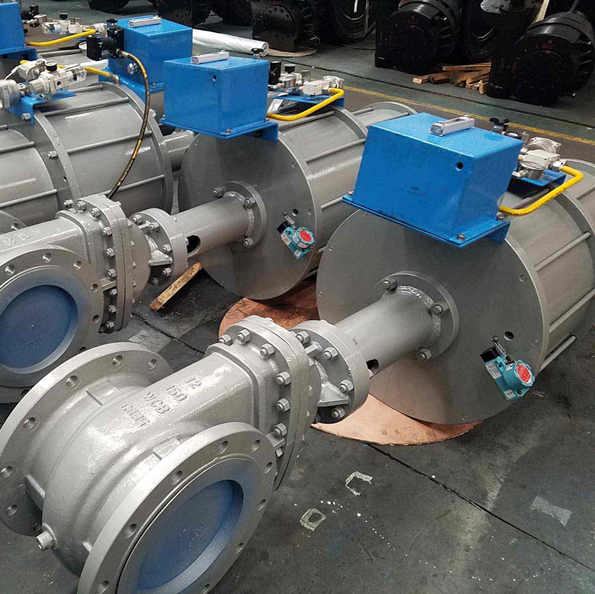
I. Overview of pneumatic actuators
Pneumatic actuators use air pressure to drive opening and closing or adjusting valves. The main types are diaphragm or diaphragm type, linear piston type, scotch yoke type and rack and pinion type.
The diaphragm type has a small stroke and can only directly drive the valve stem; while the linear piston type has a long stroke and is suitable for occasions requiring greater thrust. The scotch yoke type pneumatic actuator has the characteristics of large torque, small space, and the torque curve is more in line with the torque curve of the valve, but it is not very beautiful; it is often used on valves with high torque. The rack-and-pinion pneumatic actuator has the advantages of simple structure, stable and reliable action, and safety and explosion protection,which is widely used in the production process with high safety requirements such as power plants, chemical industries, and oil refining.
II.Working principle of pneumatic actuator
1. Double acting pneumatic actuator
When the air source pressure enters the cavity between the two pistons of the cylinder from the air port (2), the two pistons are separated and move toward the ends of the cylinder, and the air in the air chambers at both ends is discharged through the air port (4), and the two piston racks are synchronized at the same time Drive the output shaft; (gear) rotate counterclockwise. Conversely, when the air source pressure enters the air chambers at both ends of the cylinder from the air port (4), the two pistons move toward the middle of the cylinder, and the air in the middle air chamber is discharged through the air port (2), and the two piston racks simultaneously drive the output shaft (gear) ) Rotate clockwise. (If the piston is installed in the opposite direction, the output shaft will become reverse rotation)

2. Single-acting pneumatic actuator
When the air source pressure enters the cavity between the two pistons of the cylinder from the air port (2), the two pistons are separated and moved toward the ends of the cylinder, forcing the springs at both ends to compress, and the air in the air chambers at both ends is discharged through the air port (4). Synchronize the two piston racks to drive the output shaft (gear) to rotate counterclockwise. After the air source pressure is reversed by the solenoid valve, the two pistons of the cylinder move in the middle direction under the elastic force of the spring, the air in the middle cavity is discharged from the air port (2), and the two piston racks simultaneously drive the output shaft (gear) Rotate clockwise. (If the piston is installed in the opposite direction, the output shaft will become reverse rotation when the spring is reset).

III.Types of pneumatic actuators
1. Diaphragm actuator
The diaphragm type actuator can be used for a general control valve The signal pressure P of the pneumatic diaphragm actuator acts on the diaphragm to deform it, and drives the push rod on the diaphragm to move, so that the valve trim is displaced, thereby changing the valve opening. It has simple structure, low price, convenient maintenance and wide application.
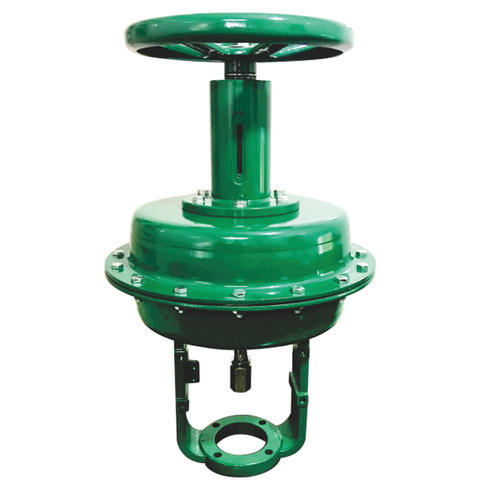
Pneumatic diaphragm actuators have two forms of direct action and reverse action. When the signal pressure from thecontroller or valve positioner increases, the downward movement of the valve stem is called a positive acting actuator; when the signal pressure increases, the upward movement of the valve stem is called a counteracting actuator. The signal pressure of the positive acting actuator is passed into the diaphragm air chamber above the corrugated diaphragm; the signal pressure of the counteracting actuator is passed into the diaphragm air chamber below the corrugated diaphragm. By replacing individual parts, the two can be retrofitted to each other.
2. Linear piston type actuator
The pneumatic piston actuator makes the piston move in the cylinder to generate thrust. Obviously, the output force of the linear piston type is much greater than that of the diaphragm type. Therefore, the diaphragm type is suitable for occasions with small output and high precision; the linear piston type is suitable for occasions with large output, such as large diameter, high pressure drop control or gate valve pushing device.
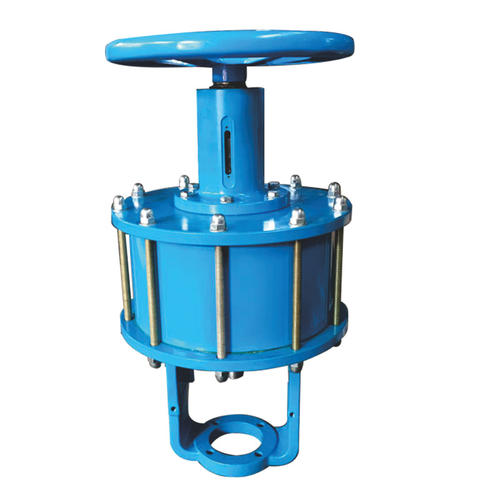
The signal standard received by the pneumatic actuator is 0.02 to 0.1MPa. The main components of pneumatic piston actuator are cylinder, piston and push rod. The piston in the cylinder moves with the pressure difference between the two sides of the cylinder. According to the characteristics, it is divided into two types: proportional and two-position. According to the two-position type, the piston is pushed from the high pressure side to the low pressure side according to the operating pressure on both sides of the input piston. The proportional type is to add a valve positioner on the basis of the two-position type, so that the displacement of the push rod is proportional to the signal pressure.
3. Scotch yoke pneumatic actuators
Scotch yoke pneumatic actuators are used for heavy duty and high frequency services, which is assembled with large torque valves. It ensures the continuous safety and corrosion resistance during the most hazardous conditions.
The symmetrical and inclined steel yoke mechanism of the high-power scotch yoke type pneumatic actuator allows two types of torque output characteristics. Among them, the inclined steel scotch yoke mechanism has very high starting torque and lower operating torque, which is suitable for the control of butterfly valves; the symmetrical steel scotch yoke mechanism has a more balanced torque curve, which is mainly suitable for ball valves and plug valve.
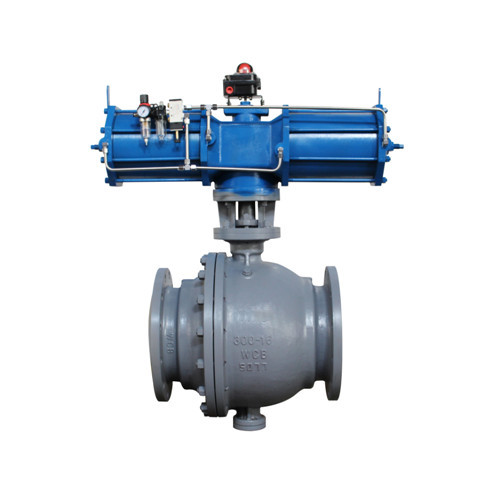
The rack and pinion type pneumatic actuator has the characteristics of compact structure, beautiful appearance, quick response, stable operation and long service life. All accessories adopt the most advanced anti-corrosion treatment technology, which can adapt to various harsh working conditions. Its high and low temperature and various special stroke actuators have good performance in various application fields.
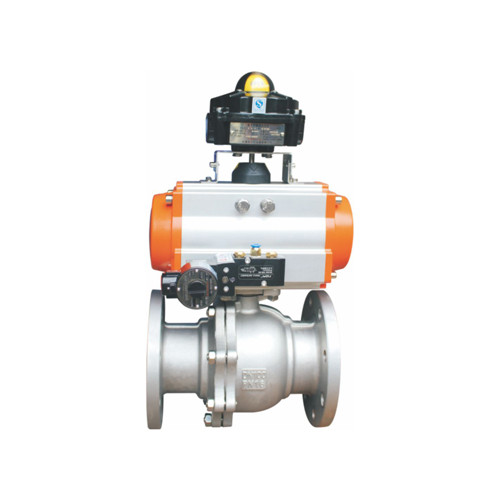
Its features are as follows:
(1)Compact twin rack-and-pinion structure, precise meshing, high efficiency, and constant output torque.
(2)The aluminum cylinder, piston and end cover have the lightest weight compared with the actuator of the same specification structure.
(3)The cylinder body is made of extruded aluminum alloy and is treated with hard anodic oxidation. The inner surface has a hard texture, high strength and hardness. The sliding bearing made of low-friction materials avoids direct contact between metals, has low friction coefficient, flexible rotation and long service life.
(4)The installation and connection dimensions of pneumatic actuators and valves are designed according to international standards ISO5211, DIN3337 and VDI/VDE3845, and can be interchanged with ordinary pneumatic actuators.
(5)The adjustment screws at both ends can adjust the opening angle of the valve.
IV.Selection of pneumatic actuators
Before selecting a pneumatic actuator, please check and confirm the valve torque. Then increase the safety factor of torque according to the specific medium. For example, increases the safety value by 25% for water vapor or non-lubricating liquid medium; increase the safety value by 30% for non-lubricating slurry liquid medium. When the valve torque is 210NM, the air source pressure is only 5bar, and the medium is non-lubricated water vapor, considering safety factors, increase the safety value by 25%, which is 262NM, and look up the air according to the double-acting output torque table. The corresponding torque value when the source pressure is 5bar. Should choose 277NM, the model is AT300.
|
Model |
2.5bar |
3.0bar |
3.5bar |
4.0bar |
4.5bar |
5.0bar |
5.5bar |
6.0bar |
7.0bar |
|
AT20 |
8.3 |
10 |
11.6 |
13.3 |
15 |
16.6 |
18.3 |
19.9 |
23.3 |
|
AT40 |
14.7 |
17.6 |
20.5 |
23.5 |
26.4 |
29.3 |
32.2 |
35.2 |
41 |
|
AT80 |
29.1 |
34.9 |
40.7 |
46.5 |
52.3 |
58.2 |
64 |
69.8 |
81.4 |
|
AT130 |
45.7 |
54.9 |
64 |
73.2 |
82.3 |
91.5 |
101 |
110 |
128 |
|
AT200 |
66.5 |
79.7 |
93 |
106 |
120 |
133 |
146 |
160 |
186 |
|
AT300 |
138 |
166 |
194 |
221 |
249 |
277 |
304 |
332 |
387 |
|
AT500 |
217 |
261 |
304 |
348 |
391 |
434 |
478 |
521 |
608 |
|
AT850 |
283 |
340 |
397 |
453 |
510 |
567 |
623 |
680 |
793 |
|
AT1200 |
383 |
459 |
536 |
612 |
689 |
765 |
842 |
918 |
1071 |
|
AT1750 |
531 |
638 |
744 |
850 |
956 |
1063 |
1169 |
1275 |
1488 |
|
AT2500 |
935 |
1122 |
1309 |
1496 |
1683 |
1870 |
2057 |
2244 |
2618 |
|
AT4000 |
1347 |
1617 |
1886 |
2156 |
2425 |
2695 |
2964 |
3234 |
3772 |
V. The performance characteristics of pneumatic actuators
1. It receives continuous air signals and output linear displacement;
2. There are positive and negative functions;
3. The moving speed is high, but the speed will slow down when the load increases;
4. The output force is related to the operating pressure;
5. High reliability, but the valve cannot be maintained after the air supply is interrupted;
6. It is inconvenient to realize segment control and program control;
7. Simple maintenance and good adaptability to the environment;
8. Higher output power;
9. With explosion-proof function.
Contact: Zhang Heng (Bill )
Phone: 86 13634285240
Tel: 86 0577 86915200
Email: cspneumatic@hotmail.com
Add: Yongqiang High Technology Developing Zone, Wenzhou, China.